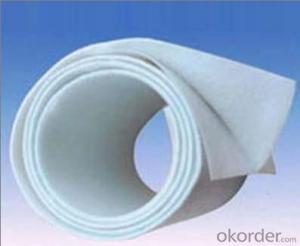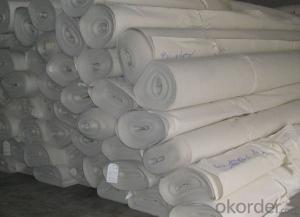Polypropylene Non-woven Geotextile for Drainage Function
- Loading Port:
- Qingdao
- Payment Terms:
- TT OR LC
- Min Order Qty:
- 20000 m²
- Supply Capability:
- 1500000 m²/month
OKorder Service Pledge
OKorder Financial Service
You Might Also Like
Description of Polypropylene Non-woven Geotextile for Drainage Function:
Nonwoven geotextiles are multi-purpose fabrics that are felt-like in appearance. There are numerous practical applications for nonwoven geotextiles. Nonwoven drainage fabrics are an economical alternative to graded aggregate and sand filters and can eliminate many of the problems associated with using, purchasing and transporting aggregate
Features of Polypropylene Non-woven Geotextile for Drainage Function:
Can withstand the installation stresses
UV stabilized
High chemical resistance
Optimum elongation
Technical Parameters of Polypropylene Non-woven Geotextile for Drainage Function:
NO. | Item Value | Specification | Note | ||||||||||
100 g | 150g | 200g | 250 g | 300 g | 350 g | 400 g | 450 g | 500 g | 600 g | 800 g | |||
1 | Weight Variation% | -8 | -8 | -8 | -8 | -7 | -7 | -7 | -7 | -6 | -6 | -6 | |
2 | Thickness mm≥ | 0.9 | 1.3 | 1.7 | 2.1 | 2.4 | 2.7 | 3.0 | 3.3 | 3.6 | 4.1 | 5.0 | |
3 | Width Variation % | -0.5 | |||||||||||
4 | Breaking Strength KN/m ≥ | 2.5 | 4.5 | 6.5 | 8.0 | 9.5 | 11.0 | 12.5 | 14.0 | 16.0 | 19.0 | 25.0 | MD and TD |
5 | Elongation at Break % | 25~100 | |||||||||||
6 | CBR Mullen Burst Strength KN≥ | 0.3 | 0.6 | 0.9 | 1.2 | 1.5 | 1.8 | 2.1 | 2.4 | 2.7 | 3.2 | 4.0 | |
7 | Sieve Size O90 mm | 0.07~0.2 | |||||||||||
8 | Vertical Permeability | K× (10-1~10-3) | k=1.0-9.9 | ||||||||||
9 | Tear Strength KN≥ | 0.08 | 0.12 | 0.16 | 0.20 | 0.24 | 0.28 | 0.33 | 0.38 | 0.42 | 0.46 | 0.6 | MD |
FAQ:
What is the main application of Polypropylene Non-woven Geotextile for Drainage Function?
The main application of our Polypropylene Non-woven Geotextile for River Construction is as follows: The highway, railway, soil-stone dam, breakwater, airport, backfill soil of retaining wall, slope protection, etc.
Where is your main market?
Our main market is in Middle East, South America and some African countries.
What is your advantages for Polypropylene Non-woven Geotextile for Drainage Function?
One of the largest manufacturer of Polypropylene Non-woven Geotextile for River Construction for Construction with advanced equipment, big production capacity and excellent quality.
- Q:What is the difference between woven and non-woven geotextiles?
- Woven geotextiles are made by interlacing yarns or fibers together in a regular pattern, creating a strong and durable fabric. Non-woven geotextiles, on the other hand, are manufactured by bonding or felting fibers together, forming a random web-like structure. This results in a fabric that is less strong but offers excellent filtration and drainage properties. In summary, woven geotextiles are stronger and more suitable for applications requiring high tensile strength, while non-woven geotextiles are ideal for filtration and drainage purposes.
- Q:Concrete panel shop asphalt do not add geotextiles
- Plus no geotextile cloth according to the design requirements and construction specifications. Generally require high road construction need to lay geotextile. Geotextile manufacturers to answer your questions
- Q:How are geotextiles different from other geosynthetic materials?
- Geotextiles are a type of geosynthetic material that is specifically designed to provide filtration, separation, and reinforcement functions in civil engineering projects. Unlike other geosynthetic materials such as geogrids or geomembranes, geotextiles are primarily used for their filtration properties, allowing water to pass through while retaining soil particles. They are typically made from synthetic fibers, which give them high tensile strength and durability. Overall, geotextiles serve a distinct purpose within geosynthetic materials, focusing on filtration and soil stabilization applications.
- Q:Woven geotextile customs code is how much
- To see what material system, even if there are many kinds of chemical fiber, such as long fiber staple fiber, polyester nylon and what process after dyeing, yarn dyed, printing and other processes are impregnated coating, etc. you reported a name not check of
- Q:What are the different testing methods for geotextiles?
- Some of the different testing methods for geotextiles include tensile strength testing, puncture resistance testing, tear strength testing, burst strength testing, and water flow testing. These tests help evaluate the performance and durability of geotextiles in various applications.
- Q:Pvc waterproof board and geotextile must be used with what
- Since the waterproof board is used for waterproofing, afraid to be punctured, and geotextile with the use of the soil and the waterproof board is set between a protective layer, so most of the waterproof board should be used with geotextile. However, if the soil clean up, no sharp foreign body, but also consider not set geotextile.
- Q:Do you need to use geotextile for construction site? Mainly used where?
- Used in road, railway tunnel waterproof board behind, wrapped blind pipe, roadbed blind ditch, roadbed filter layer and so on.
- Q:Can concrete slabs be placed directly on geotextiles?
- Huazhi geotextile material manufacturers
- Q:What are the different geotextile performance properties?
- Some of the different geotextile performance properties include filtration, separation, drainage, erosion control, reinforcement, and cushioning.
- Q:Can geotextiles be used for erosion control in river levees?
- Yes, geotextiles can be used for erosion control in river levees. They are commonly used as a protective barrier to prevent soil erosion and stabilize the levee slopes. Geotextiles can effectively control erosion by providing reinforcement and filtration, reducing water velocity and sediment movement, and promoting vegetation growth.
1. Manufacturer Overview |
|
|---|---|
| Location | |
| Year Established | |
| Annual Output Value | |
| Main Markets | |
| Company Certifications | |
2. Manufacturer Certificates |
|
|---|---|
| a) Certification Name | |
| Range | |
| Reference | |
| Validity Period | |
3. Manufacturer Capability |
|
|---|---|
| a)Trade Capacity | |
| Nearest Port | |
| Export Percentage | |
| No.of Employees in Trade Department | |
| Language Spoken: | |
| b)Factory Information | |
| Factory Size: | |
| No. of Production Lines | |
| Contract Manufacturing | |
| Product Price Range | |
Send your message to us
Polypropylene Non-woven Geotextile for Drainage Function
- Loading Port:
- Qingdao
- Payment Terms:
- TT OR LC
- Min Order Qty:
- 20000 m²
- Supply Capability:
- 1500000 m²/month
OKorder Service Pledge
OKorder Financial Service
Similar products
New products
Hot products
Related keywords

































